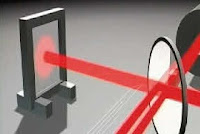 |
| Illustration of laser interferometer |
Scientists are now seeking to prove the existence of these waves using laser interferometers, which can detect tiny changes in the length of an object which might be indicative of gravity waves. Project LIGO, funded by the National Science Foundation, has build two laser interferometers, each one consisting of two perpendicular laser tunnels two and a half miles long. This is obviously extremely expensive and one may wonder if it's worth the cost. But some of the technologies developed for the interferometers have other uses as well, so there's definitely a payback of sorts, even if gravity waves are never found.
Project LIGO is examined on the current episode of Future Talk, which features two Stanford physicists who work on the project. Brian Lantz has his Ph.D. from MIT, and Riccardo Bassiri has his Ph.D. from the University of Glasgow, Scotland. In addition to showing some fascinating video produced by the National Science Foundation, they also give in-studio demonstrations of some of the equipment used in Project LIGO. If you'd like to view the entire episode, click here. If you'd like to view it broken down into three shorter segments, click here.
No comments:
Post a Comment